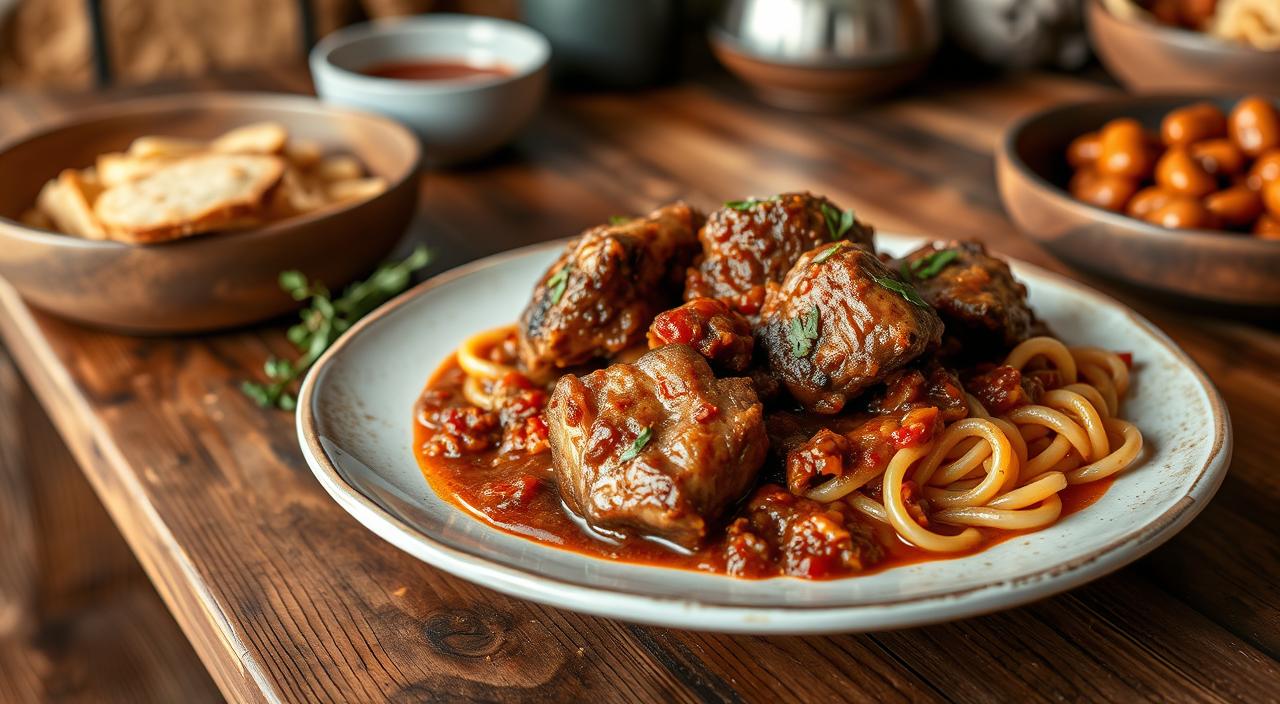Try the amazing mix of bison and wild boar in this tasty ragu recipe. This dish is perfect for cozy nights at home. It’s not just delicious, but also a healthier choice than regular meats. It’s a great way to enjoy wild game cooking.
This meal is sure to make your home feel warm and welcoming. Every bite is a treat for your taste buds. It’s a gourmet dish that’s easy to make and fun to eat.
Key Takeaways
- Combines bison and wild boar for a flavorful hearty ragu.
- Spotlights the unique characteristics of wild game cooking.
- Offers a gourmet dish that’s perfect for cozy evenings.
- Encourages the use of sustainable and nutritious alternatives.
- The rustic sauce envelops your senses in rich flavors.
- Discover more wild game recipes to enhance your cooking repertoire here.
Introduction to Bison and Wild Boar
Bison and wild boar are two unique meats that add flavor to dishes. Bison meat is lean and high in protein, making it a great choice for health lovers. It tastes subtly sweet, which makes it perfect for many recipes.
Wild boar has a rich and complex flavor, unlike regular pork. It’s great for many dishes, from hearty stews to fancy ragu. Its unique taste can make any dish stand out.
Both bison and wild boar are not just tasty but also good for you. Bison is packed with iron and B vitamins, which help with energy and a strong immune system. Wild boar is full of omega fatty acids, which are good for the heart and overall health.
More people are choosing wild game like bison and wild boar for their sustainability and unique flavors. Chefs and home cooks love them for these reasons. For a tasty wild boar recipe, try this Wild Boar Bolognese recipe.
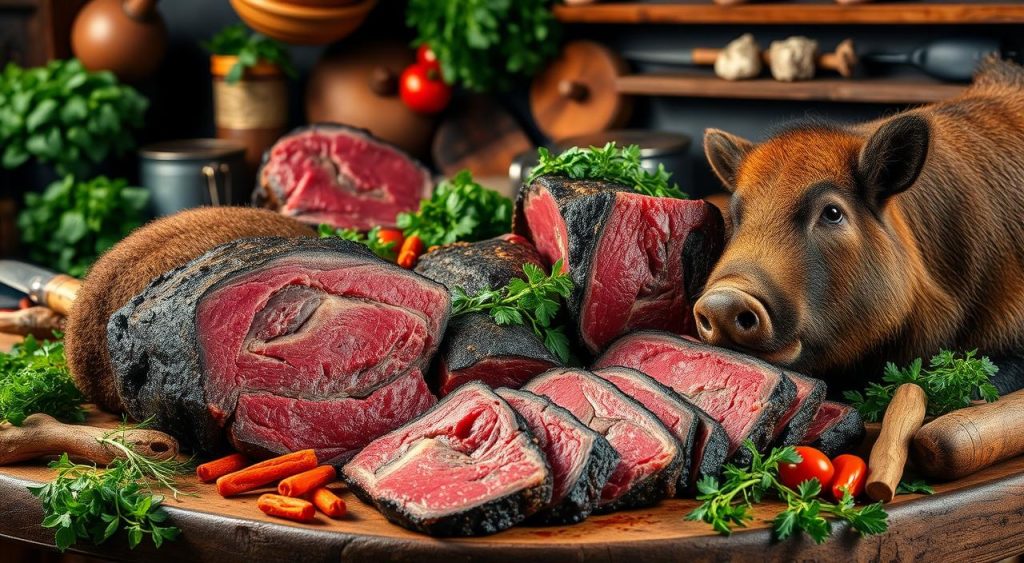
The Rich Flavors of Wild Game
Exploring wild game flavors opens up new culinary adventures. Bison and wild boar bring unique and bold tastes to traditional dishes. Bison has a slightly sweet and earthy flavor. This makes it great with strong sauces and spices.
Wild boar has a deeper, more complex taste. Its flavor can be nutty, depending on what it eats. When used in ragu, these flavors blend well, making the dish richer. Knowing about these flavors helps us enjoy the special tastes of wild meats more.
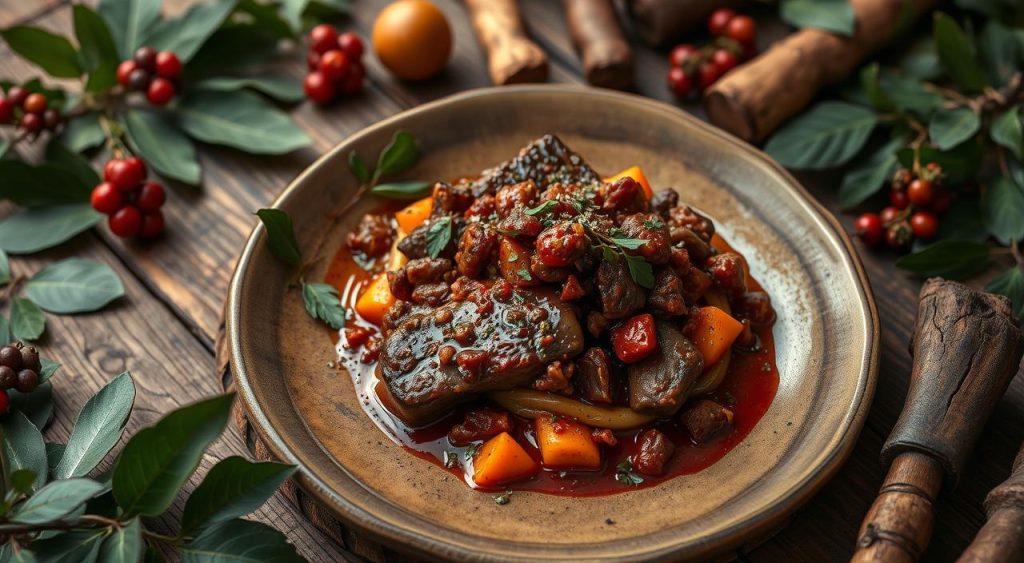
Understanding Ragu: A Culinary Tradition
Ragu sauce is a key part of Italian cuisine, showing the long history of cooking traditions. It comes from Italy and is made with meat, veggies, and tomatoes. The secret to a great ragu is cooking it slowly, letting the flavors blend together.
Every region in Italy has its own version of ragu, showing off local tastes and ingredients. For example, Bolognese ragu from Bologna uses ground meat and a bit of milk. This makes the sauce creamy and perfect with pasta. It’s not just about cooking; it’s about sharing meals and being together in Italian culture.
Making the perfect ragu sauce takes time and care. It’s all about adding flavors slowly and paying attention to every detail. When you try making ragu, you’re joining a tradition of love, passion, and delicious food.
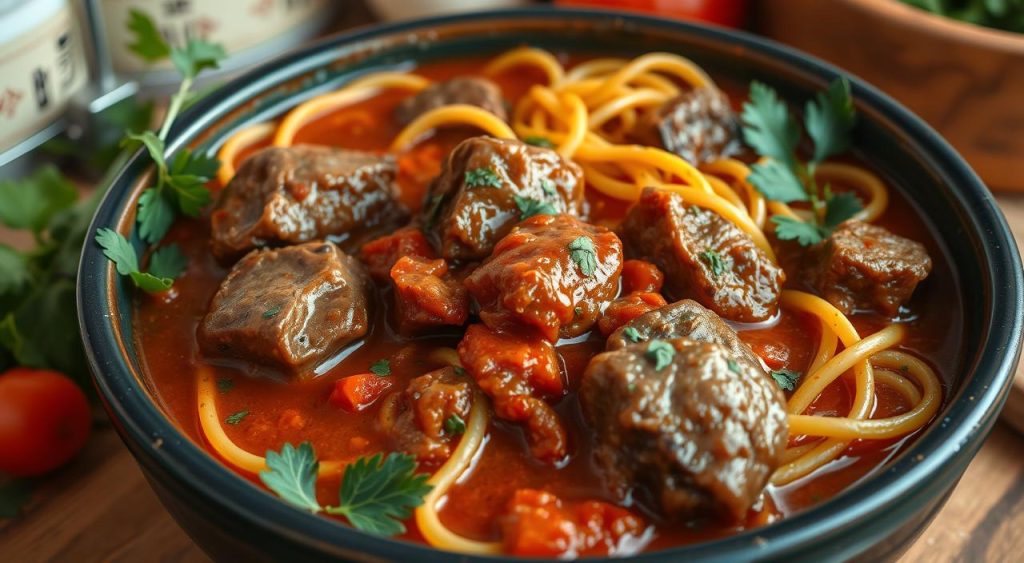
Ingredients for Bison in Wild Boar Ragu Recipe
Choosing the right ingredients is key for a great bison in wild boar ragu. It’s important to know about bison and wild boar cuts. This guide will help you pick the best ingredients for a memorable meal.
Choosing the Right Bison Meat
For bison meat, go for chuck or sirloin cuts. These are perfect for slow cooking, which brings out rich flavors. Make sure to choose cuts with a good mix of lean meat and some fat for tenderness and taste.
Selecting Wild Boar Cuts
For wild boar, use shoulder or leg cuts. These are full of flavor and great for ragu. Slow braising makes the meat tender and full of flavor, blending well with the sauce.
Other Essential Ingredients
Don’t forget to add ripe tomatoes, garlic, onions, and fresh herbs to your ragu. These ingredients are crucial for a deep, rich flavor. Using quality olive oil and seasoning right can take your ragu to the next level.
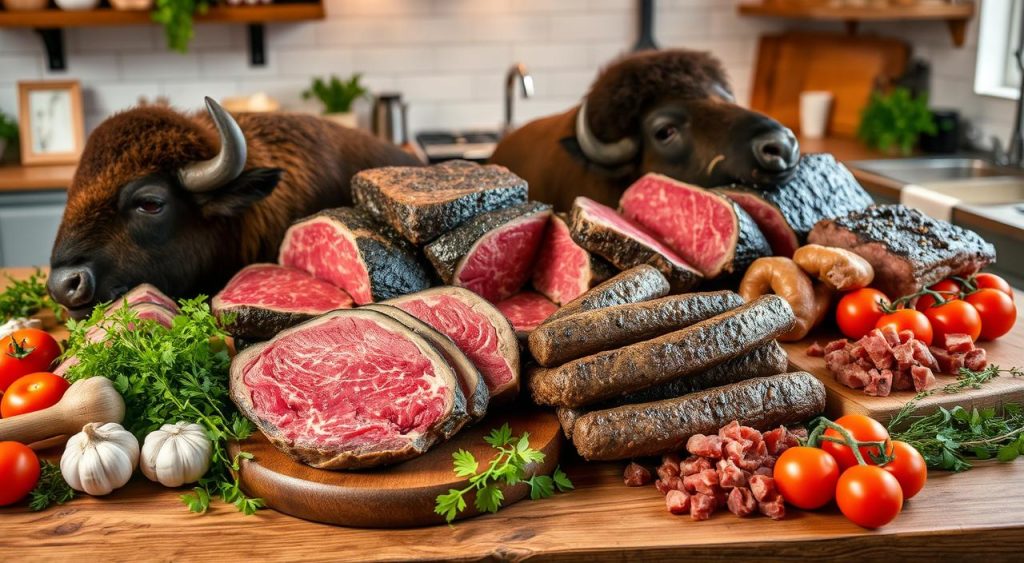
Preparation Steps for Bison in Wild Boar Ragu Recipe
Starting with the ragu preparation steps is key to a great dish. First, prepare the bison and wild boar meats. Make sure the cuts are trimmed and diced evenly. This ensures even cooking and improves the ragu’s texture.
Then, chop the onions, carrots, and celery into small pieces. These vegetables add a lot of flavor to the dish. Having them ready before you start cooking makes the process smoother.
Seasoning is crucial at every step. Add salt and pepper to the meat as you dice it for early flavor. You can adjust more seasoning during the cooking process to taste.
Before you begin cooking, collect all your ingredients in one spot. This is called mise en place and keeps your cooking area tidy. Having everything organized helps you work efficiently and avoids distractions while you cook.
Cooking Techniques for Optimal Flavor
To make a ragu with deep flavors, you need to master certain cooking techniques. Searing and slow cooking are key for flavor development. Each method improves the taste and texture of the dish.
Sear and Brown for Depth
Meat searing is vital for boosting flavor. When you sear bison and wild boar at high heat, they get a savory crust. This crust, thanks to the Maillard effect, adds complex flavors to your ragu. You want the outside to be golden-brown and the inside juicy.
Use a heavy skillet or Dutch oven for this. Don’t overcrowd the pan to keep the heat right.
Slow Cooking Methods Explained
Slow cooking ragu lets the flavors of bison and wild boar blend together. This method makes the meat tender by breaking down tough parts. As it cooks, the flavors get richer, making the sauce more delicious.
Keep the heat low for a few hours. Let the ragu simmer slowly. Use a lid to keep moisture in and help the flavors mix well.
Pairing Options for Your Ragu Dish
Choosing the right sides for your meal can make all the difference. For bison in wild boar ragu, finding the right ragu pairings can elevate your dining experience. The rich sauce works well with sides that balance its bold flavors.
Try serving creamy polenta as a base. Its smooth texture is perfect for soaking up the sauce. Homemade pasta is also great, adding a comforting touch that makes the dish even better. Rustic bread is another excellent choice, offering a satisfying crunch and helping you enjoy every bite of the ragu.
Adding fresh elements is also key. Seasonal vegetables or a crisp salad bring a refreshing touch to the rich ragu. These additions make sure your meal is both nourishing and enjoyable.
Serving Suggestions and Garnishes
Make your bison in wild boar ragu meal special with great serving ideas and garnishes. Adding the right touches can make the meal unforgettable.
Perfect Side Dishes
Choose side dishes that bring out the best in your ragu. Here are some great options:
- Crusty artisanal bread, perfect for sopping up the delicious sauce.
- Seasonal roasted vegetables, which add freshness and color to your plate.
- Mashed potatoes or polenta, providing a creamy texture that pairs nicely.
Wine Pairing Recommendations
Choosing the right wine can make your meal even better. Go for full-bodied red wines to match your ragu. Here are some top picks:
- Cabernet Sauvignon, which offers rich tannins and dark fruit flavors.
- Chianti, characterized by its acidity that complements the meatiness of the dish.
With these tips on serving, garnishes, and wine, your bison in wild boar ragu will impress everyone.
Conclusion
Preparing bison in wild boar ragu is a rewarding and enriching experience. It brings together the rich heritage of game meats. This dish shows how thoughtful cooking can bring out deep flavors.
The mix of bison and wild boar makes your recipes more exciting. It adds a new twist to traditional ragu. This dish is great for sharing with loved ones, making any meal memorable.
Now, it’s time to take on this unique culinary challenge. Try the detailed steps and rich flavors in the bison ragu recipe. Let’s enjoy this delicious dish and share our cooking stories.
FAQ
What meats are used in the bison in wild boar ragu recipe?
The recipe uses bison meat and wild boar. Both add unique flavors to the ragu.
How do the flavors of bison and wild boar differ?
Bison has a slightly sweet and earthy taste. Wild boar is richer and nuttier. This mix creates a diverse flavor.
What are the nutritional benefits of bison and wild boar?
Bison is lean and high in protein, with less fat than traditional beef. Wild boar adds a complex flavor and is a sustainable choice.
What makes ragu a culinary tradition?
Ragu is a beloved Italian sauce made with meat, veggies, and tomatoes. It’s known for its deep flavor from slow cooking.
Which cuts of bison are best for making ragu?
Use bison chuck or sirloin for slow cooking. These cuts become tender and flavorful when cooked slowly.
What are the key preparation steps for the ragu?
Start by dicing veggies and seasoning the meats. Make sure all ingredients are ready for slow cooking.
How does searing the meat affect the dish?
Searing the meats creates a rich, brown crust. This adds depth and enhances the ragu’s flavor.
What are the best side dishes to serve with ragu?
Serve with creamy polenta, homemade pasta, or rustic bread. These sides balance the dish’s richness well.
What wine pairs well with bison in wild boar ragu?
Choose a full-bodied red wine like Cabernet Sauvignon or Chianti. These wines complement the ragu’s rich flavors.

